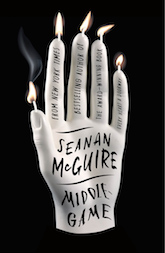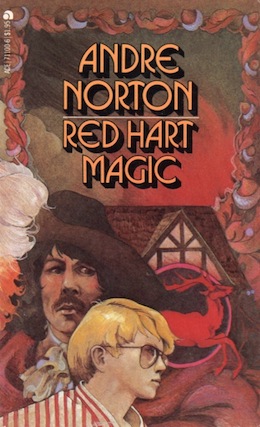I truly cannot remember if I read this book back when it was first published, around about 1976. It’s possible. If so, I’ve forgotten everything about it except a very dim memory of the inn.
But there are so many magical inns in fantasy literature, and Red Hart Magic is so clearly connected with the rest of the books in the Magic series, that I might be picking up on the tropes rather than actually remembering an earlier read of this particular novel. The themes here touch just about point for point with the rest of the series: the smaller image of a real building (Octagon Magic, with hints of the hidden house in Steel Magic and the puzzle-inside-the-doomed-magical-house in Dragon Magic and the house within the garden maze in Lavender-Green Magic), the children separated from their parents and sent unwillingly to live with a relative (all of the books), the girl’s grandmother sent away for health reasons to a place where the girl can’t join her (Octagon Magic).
The parallels with Octagon Magic are particularly strong. There’s the busy working aunt living in an apartment in a nameless city, the mean kids of both genders, and the time travel to a succession of different periods through the miniature house. This time there’s a boy as well as a girl, with conflict between them as well as with the kids at school, and the added tension of their parents having married each other so that they’re now, completely unwillingly, brother and sister.
It’s as if Norton lined up all the elements of the previous volumes, thought carefully about what she wanted to say and how best to say it, and worked it all in together to appeal to both male and female readers. Of course her protagonists have to learn life lessons—that’s the point of all the books—but she does this through a rapidly paced adventure with lots of tension and suspense in both the present and the time-traveling past.
One thing she does not do, which is a departure from the earlier books, is make a conscious effort to diversify her cast. Everybody is white-bread American, though there’s a hint that Nan may be a brown person—it’s mentioned in passing that her tan doesn’t completely fade in the winter. In a way this is a retreat, presaging the whitewashing of fantasy through the Eighties and Nineties, but from the perspective of 2019 it’s kind of a relief. Norton is in her comfort zone here, telling the interwoven stories of an English inn through the ages and a pair of kids in a Midwestern-esque city, and there’s an ease and confidence in the writing that makes the book, at least for me, a pleasure to read. She’s home, and it shows.
Within the constraints of what it is, this is a really enjoyable book. The kids’ viewpoints switch back and forth so that we know how each is misreading the other, and we get the full picture of which each has only half. The time-traveling episodes are vivid and nicely detailed, and though they tend to break off without a clear conclusion, there’s enough context to make clear what happens after the kids return to the present. The present-day conflicts with mean kids resolve nicely through lessons from the past; there’s a distinct didactic purpose to the plotting, but it manages to skirt the dull or the preachy.
The ending is abrupt even by Norton standards—we never do find out what the “surprise” is that the parents promise, though the kids are sure they know—but the way the pages were counting down, I knew the cutoff was coming. It wasn’t too frustrating when it happened. I’d been primed for it by the way the adventures in the inn tended to stop before they achieved closure; it seemed natural enough for the book to end the same way.
As I read, the story felt remarkably real. I swear I knew those kids, both the good ones and the bad ones. I was a sullen tween and an even more sullen teen, and I would have given just about anything to go time-traveling with the help of a toy inn. I’d have preferred dragons to the Gentlemen, to be honest, and ancient Egypt to early modern England, but the familiarity of the English past does have a certain charm.
So does the contemporary-for-Norton setting. It’s so utterly Seventies. From the decor of the aunt’s apartment—orange and green in clashing shades—to what passes for Chinese food, I kept alternating between “Oh god” and “Oh yes.” It’s just as much of a historical artifact as the different periods of English history which the kids visit.
Buy the Book


Middlegame
A couple of things stuck out for me, one about the series and one about Norton in general.
In the series, women do not need men to have active working lives. There’s nothing unusual about it; no one makes tut-tutting noises. It’s the way things are. Grandmothers get sick and need care, but there’s no mention of grandfathers. If the grandfather is in the picture, as in Lavender-Green Magic, he’s a solid part of the team, but there no sense that the grandmother without him is any less a complete person. Aunts can be single and have well-paying jobs, and will get saddled with the kids when the rest of the support network is unavailable, but there’s no suggestion that they need male help to get the job done. When they do enlist help, as often as not it’s other women with kids.
Men raise kids, too, I should note. In Fur Magic the kid-raising crew is all male. Chris and his dad are a unit; the marriage to Nan’s mom disrupts it. When they do finally make a new and larger unit, there’s a sense that everybody is equal. They all hold up their corners. Chris has to do household chores at his aunt’s, just as Nan does. He’s not happy about it, but Aunt Elizabeth doesn’t let him off because he’s a boy.
This is subversive and quietly feminist. In 1976, Norton must have felt she could get away with it. She may even have felt that it was essential to the way she wanted the world to work.
The other aspect that stood out to me has been pinging at me throughout this reread, and that’s the way Norton’s plots move the characters. Characters do things without knowing why—over and over. Just suddenly it comes to them, or they find themselves acting in particular ways. Sometimes, especially in the fantasies, it feels as if they’re being moved by higher powers; once in a while we even get to see who or what those powers are. Other times, that power is the author, getting the characters from point A to point B as quickly as possible, and not taking time to develop their motivation or, as we say now, to give them agency.
I notice this because I managed to internalize it as a means of moving the plot forward, and have been called on it by more than one editor. It’s an easy way out when you’re trying to get a book done fast, and it removes the necessity of building emotional arcs and grounding the character’s actions and reactions in their personalities and histories. It is, as editors have pointed out, a shortcut.
Norton was at her best when she was writing fast action. Character development was not one of her strong points. If she needed a thing to happen, a character would do it without knowing why. Easier and quicker and much easier on the word count than rounding out the reasons for it.
For the most part, as a reader, I don’t stumble too hard over this. It’s part of the way Norton books work. If they’re moving along briskly and the characters are engaging and the adventure is interesting, that’s all I need.
I’m going to jump way ahead in the publication order for the next round, just because, and tackle the Five Senses books. The first, from 1994, is The Hands of Lyr. It will be interesting to see how, or if, her writing changed in the two decades after Red Hart Magic.
Judith Tarr’s first novel, The Isle of Glass, appeared in 1985. Her most recent novel, Dragons in the Earth, a contemporary fantasy set in Arizona, was published by Book View Cafe. In between, she’s written historicals and historical fantasies and epic fantasies and space operas, some of which have been published as ebooks from Book View Café. She has won the Crawford Award, and been a finalist for the World Fantasy Award and the Locus Award. She lives in Arizona with an assortment of cats, a blue-eyed dog, and a herd of Lipizzan horses.










